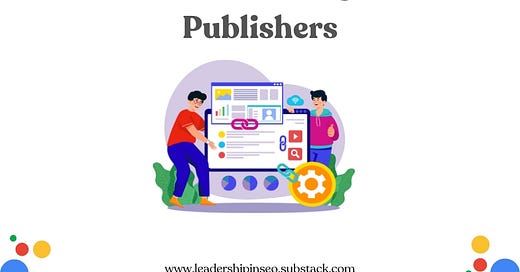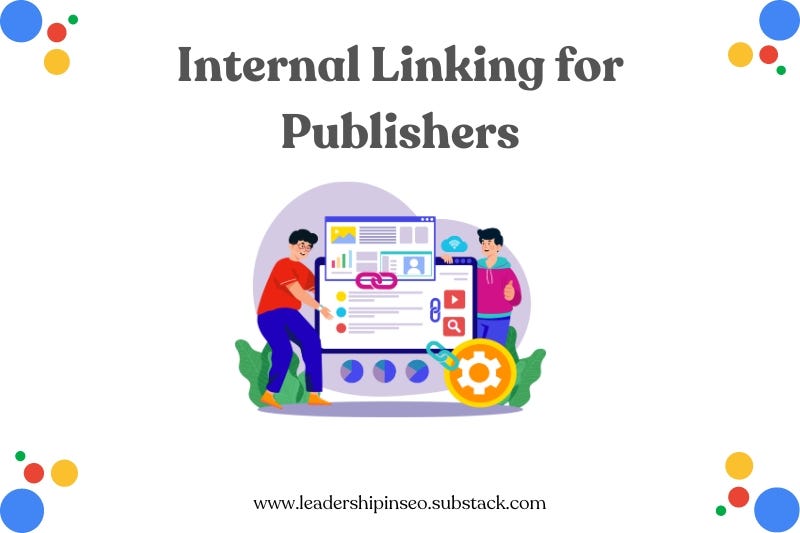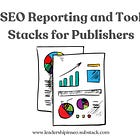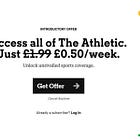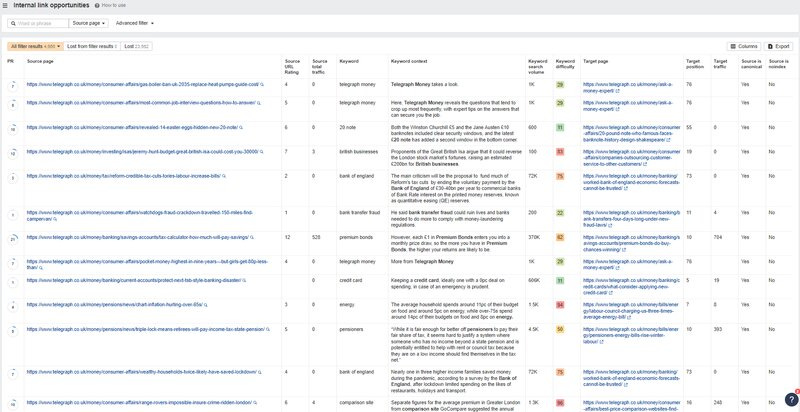Internal linking for news publishers
With so much content to play with, internal links can be one of your most potent weapons as a news publisher
TL;DR
Because who has time to read a full article?
Internal links should perform two functions
Increase engagement by keeping users on your site for longer
Helping search engines and users understand the depth and breadth of your content
Find a way to link from your news content to key evergreen content
Internal links should help define and improve the structure of your site
What is an internal link and what should it do?
An internal link is a hyperlink that points from one page on your website to another page on your website. Primarily they are designed to help users travel from one page on your site to another. Whether that’s through links in the primary navigation or through contextual in content links.
In SEO circles, internal links are discussed under more technical auspices including;
Site structure
All of which are absolutely valid. Well, to some extent. However, you should always think of an internal link as adding value to the user. If someone lands on a news article discussing the likely pension changes as part of the budget, are they also likely to be interested in evergreen pension articles like what is a good pension pot? Yes.
Are they likely to be interested in articles about the presidential election? Well, maybe. But it’s much less likely isn’t it? You must make smart, sensible decisions to improve user engagement and experience. Once someone is on your site, it’s our job as SEOs to keep them there.
What types of internal links are available?
Quite a lot for most websites, particularly larger publishers;
Homepage
The homepage tends to be the most powerful, pivotal page on your site. It’s the entry point for the majority of crawlers and - for news publishers - users. So make sure you take advantage of its ‘authority’ by placing your most prominent articles on it at the right time.
There’s a good case study on Search Engine Journal about how important internal links are on the homepage for news publishers. Well worth a read.
If you want content to be crawled and indexed quickly, nothing moves the needles like adding content to the homepage. Theoretically, the higher up you place the link on the page, the more effective this works.
Navigational
Navigational links include;
Primary navigation links
Burger navigation links
Footer links
To me, your navigation should do two things. Make it easy for your core user base to navigate your site in one click. And give search engines a clear indication of what your site and brand is really about.
There’s a very good book by Steve Krug called ‘Don’t Make Me Think’ which I would recommend reading. That one line has helped us make many decisions when it comes to menus and UX.
Contrary to lots of popular discourse, links added to your primary navigation only count for one link.
In-article
Text-based, in-article links are the best quality links you can add as SEOs. They provide the opportunity to link to evergreen articles from topical content. Linking content clusters together is a fantastic opportunity to keep relevant, engaged users on site, directing them to content where they’re more likely to convert.
Selfishly, that’s the point, isn’t it? SEO’s not that deep.
Right-hand rail
The right-hand rail is a great place to link to highly relevant articles. And typically one of the places with the highest click-through rate. Users expect to find highly relevant articles there.
I think the best way to use these rails is to have separate approaches for news and evergreen content. With news, use the right-hand rail to link to news pieces spiking in popularity. That can be split by tag or just by page views.
With evergreen content, use it to form clusters of content. The hub and spoke approach is a simple, much-heralded way of linking content together. You can still include news articles here of course.
With the advent of personalisation the right-hand rail component, navigation-based links and the More Stories blocks can be used in more effective ways for logged-in users. Anything that improves the overall experience, interactions, session duration etc should be encouraged. Just remember that Google crawls your site like a first-time, cookieless user.
More stories and related articles
Whilst these are typically placed at the bottom of the article (and are usually only seen by somewhere around 20% of users), they’re useful in creating topic clusters and linking to key evergreen articles.

Typically most websites have two blocks at the bottom of the page, and I think this is a good starting point for anyone;
Related articles: a collection of closely related stories. Make sure they’re different to the RHR to gain maximum value
More stories: a collection of articles categorised by relevant tag or popularity
Internal linking best practice for news publishers
Broadly I think there are four key things to consider;
Utilise the power of your homepage (and navigation)
Identify your priority evergreen articles and link from your news articles to them
Make sure you link to your tag pages. These pages help search engines understand what you have and continue to write about
Avoid using URL parameters when linking internally. Even for tracking purposes. They can cause duplicate content and crawl budget issues
In terms of some specific considerations…
Open in the same tab
Open all internal links in the same tab. This is the expected behaviour for users. If someone clicks on an external link, then you should ensure it opens in a new tab to keep the user on site. But with an internal link, they’re already on your site.
Anchor text
Your anchor text should be;
Relevant
Keyword-optimised (not stuffed)
Provide a very clear indication to users (and search engines) what the article you’re linking to is about
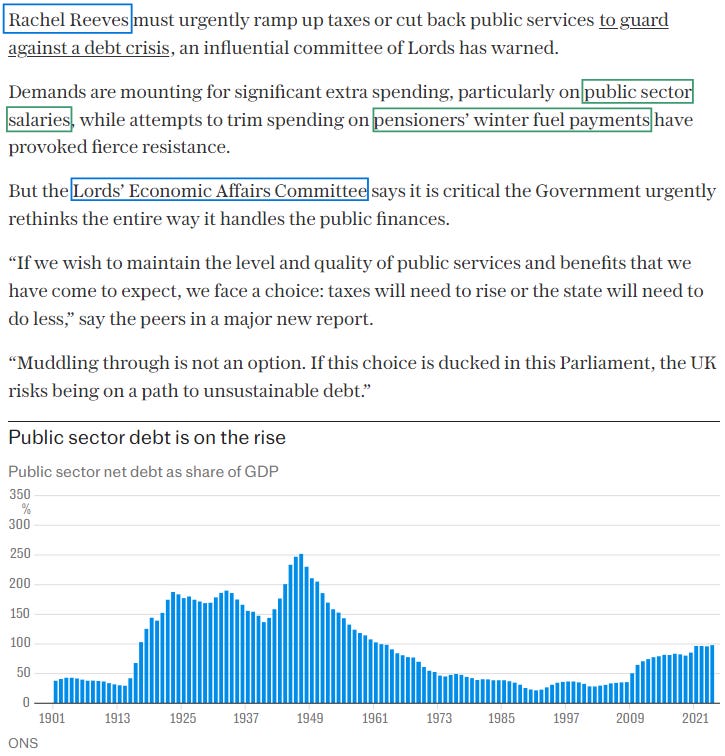
Your anchor text to tag pages should match the entity. To articles, it should include the core keyword and be a little more descriptive.
In terms of framing whether text should link to a tag page or article… If the entity in question is being referenced solely as an entity, link to a tag page. If it’s part of a broader discussion, link to an article.
Number of internal links per article
A question I’ve been asked lots of times. For news articles, I suggest just getting some relevant links into key tag and evergreen articles in the first couple of hundred words. The last thing we want to do is slow down the publishing of a page.
For evergreen articles, a link or two every hundred words is a good starting point. But wherever and whenever it makes sense for the user is better advice. If a little broad.
Link relevancy
Contextually relevant links are everything. If you place a link on a page that users don’t click very often, it’s likely a waste of time and reduces the overall page quality.
Everything matters. Page and site quality all come down to the details. If you link to articles that don’t entice a user to stick around, you reduce page engagement and the chances of ranking as effectively as you should.
Link placement
The higher up you place a link, the more value it has on a page. Arguably both to search engines and users. The lower down the page you place something, the less users are going to see it. Hence, footer links are of such low quality. Google isn’t stupid. Maybe not that clever, but it’s not that stupid.
Topic pages
In my mind, topic pages perform two key roles;
Help users find collections of content around specific topics
Group entity-specific content together for search engines
So users looking for content on a specific entity (be that person, place or brand) can trawl through your back catalogue. And search engines get a good understanding of how much content you’ve created around specific entities over time.

If we agree that ‘topical authority’ is a real thing and not something SEO’s have made up. Then the more content you’ve created about specific entities. The more links you’ve generated to these articles. The better chance you’ll stand of ranking.
Evergreen vs news content
News content may be here today gone tomorrow, but it plays a key role in helping your evergreen content to rank. Or at least it should. Fresh content and links from fresh content are important ranking signals. A passer of ‘PageRank’ from one to another.
If you have an evergreen article on something like ‘what is a good pension pot’ and there’s a significant amount of search around something like ‘how labour could take away your state pension.’ Then linking from one to another is a natural user journey.
And that’s where internal links come in. Make sure you don’t lose a person from your news article if you have evergreen content they’ll find interesting. Keep them on-site with high-quality, contextual links to your evergreen content.
Managing broken and redirecting links
This is never ending. My advice is to not get too bogged down in the details if you’re a big publisher. Run monthly crawls. Create an automated solution that pings you when a page is 404’ing and lots of users are reaching it. And only redirect pages when there’s something worth saving. Traffic or links being the big two.
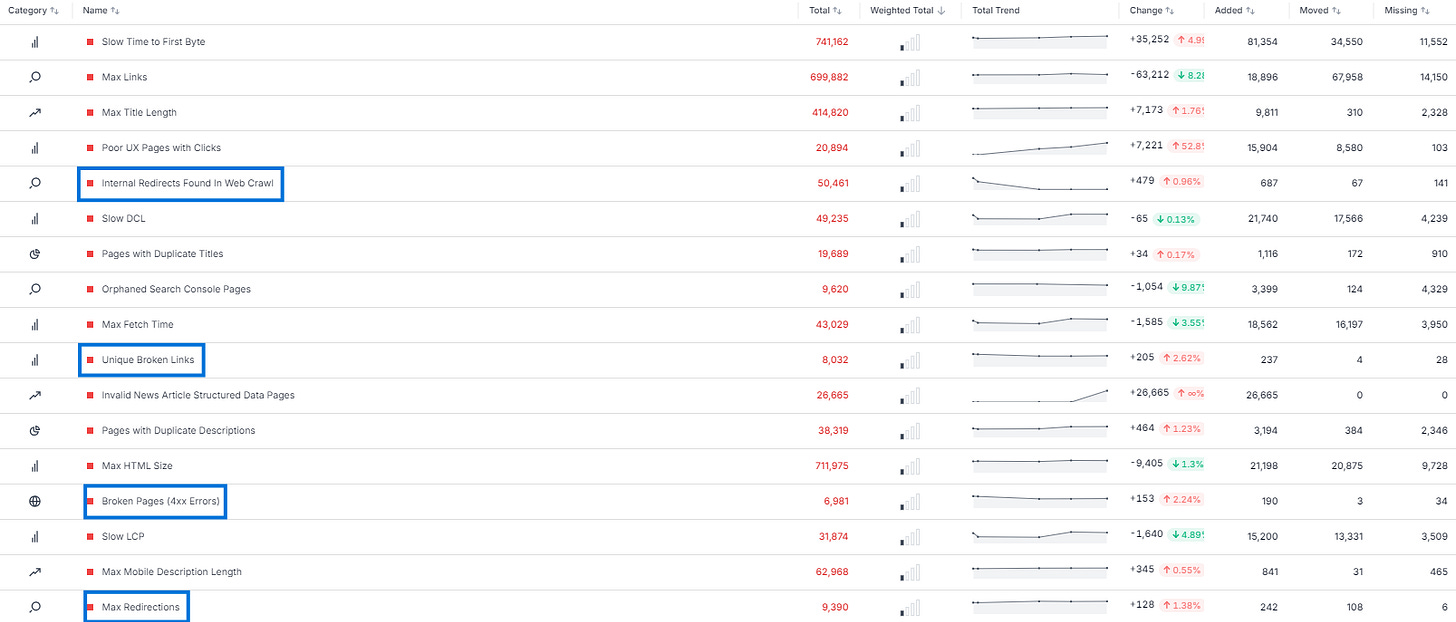
Otherwise, just save the server a little bit of work. You just don’t need to save everything. A 404 page isn’t necessarily a bad thing. If you’d rather avoid 'ambiguous’ 404s, then I suggest you create the option to serve broken pages with a 410 status code.
A 410 status code is an HTTP status code that indicates that a requested resource is no longer available and has been intentionally removed. Whereas a 404 indicates the page may exist but cannot be located. Google usually removes a resource serving a 410 from its index more quickly than a 404.
Training
You should train writers and/or production staff on the basics of internal linking. But keep it simple. If you start getting into the weeds of link placement or the optimal number of internal links per article, you’ll turn people off. Trust me. Get them to focus on;
Linking to tag pages
Identifying and linking to key evergreen articles from topical content
Using the right anchor text
Build a list of key evergreen articles with anchor text examples for production teams to use. Review key articles when they go live. And run some monthly internal linking improvements at a subfolder level.
We’ve recently been using ahrefs ‘internal linking suggestions’ tool. Having no idea it existed until the last few weeks, it’s a huge time saver. Whilst you still need to review it and set up a monthly site audit. It can save days of work.
To setup this internal linking opportunities report you’ll need;
An ahrefs account (sorry if that wasn’t obvious)
To set up a monthly site audit (I’d recommend breaking your site down into subfolders or projects here)
Once done navigate to tools > internal link opportunities
How to create and implement a publisher internal linking strategy
The first step is to evaluate your current position based on the above. Ask the key questions that will allow you to understand how your internal linking fares. I hesitate to call it an audit, but that’s what you’re doing.
Does our primary navigation make it easy for users to navigate to key pages?
Does the homepage feature our key articles prominently? Does it have enough links?
Does our topical content link to key tag pages and evergreen articles?
Is our anchor text well optimised?
How do we handle broken and redirecting links?
Do production staff have enough information to add quality internal links?
Have your key site sections been audited with this in mind recently?
Then set some KPIs around what you’re trying to achieve. You should bucket it into three key areas;
Does our internal linking work well for our users? (UX)
Do we prioritise our important content? (Authority/PageRank)
Does it improve our site and page quality score? (Technical SEO)
Now you should have a series of goals, a problem statement and a solution to take to the higher-ups.
What tools should I use?
You can create and enact an excellent internal linking strategy with very little. Just a site crawler would do it. And a little elbow grease.
But if you have the budget, the internal linking tool stack I would use includes;
ahrefs - or an automated internal link alternative
A site crawler - Screaming Frog is the best for everyone but huge publishers. Get comfortable using custom extraction if you’re searching for specific terms
A broken link checker - particularly useful for the news SEO team
Google Alerts
A site structure mapper
I think Google search operators are one of the most under-utilised tools in an SEOs arsenal. And they’re free. Let me give you some examples of how you can manipulate you search for good internal linking practice.
Example #1 - dated URLs
If you have dated URLs, you can search for keywords from more recent content with a combination of site:insertsite and inurl:date.
Example #2 - content created before or after certain points
If you want to focus solely on content created after a certain date. But don’t use dates in your URL, I have another solution for you. The phrase before: only returns results from a before a specific date. When combined with the site search operator this can be invaluable for finding recent internal links.
site:telegraph.co.uk “pension pot” before:2024
These are just two examples. There are so many ways to use search operators to your advantage when it comes to internal linking. Getting competent with them can really level up your SEO.
How you can use Google Alerts to automate internal linking opportunities
If you work for a big news publisher, you’ll know how challenging it can be to identify opportunities to link from topical content to key evergreen articles. Some of these big publishers publish 100s of articles a day. There’s just no way you can keep up with everything without finding an automated solution.
Luckily I have one for you that is both easy and, incredibly, free.
If you set up an account on Google Alerts you can track when specific queries are mentioned on your site. Or any site in fact. To do this, once you have set up an account;
Enter the search query you want to monitor in parenthesis - “pension pot”
Specify the site using site search operators - “pension pot” site:telegraph.co.uk
Set up alert preference - I’d recommend choosing ‘as it happens’ if you want to set up real time link tracking. Otherwise once a day is fine
Specify a language and region if required
Enter your email address and click the ‘create alert’ button
You will then receive emails as and when Google identifies indexed content with your specific search terms.
Top tip: you can automate this entire process and get a Google sheets output by creating an RSS feed with a Google Apps script.
Get the RSS feed URL
Go to Google Alerts and create an alert with your query.
Click on the “Show options” and select “RSS feed” under “Deliver to”.
Copy the RSS feed URL provided.
Open Google Sheets
Go to extensions > apps scripts
Write the script
Replace the default code in the script editor with the following script. Make sure to replace YOUR_RSS_FEED_URL with the URL you copied from Google Alerts.
Save and run the script
Click file > save
Click the play button (▶️) to run the script.
Set up a trigger
To automate the script to run at regular intervals, click on the clock icon (⏲️) in the Apps Script editor.
Click on + Add Trigger, and set the function to fetchAlerts, choose your desired frequency (e.g., daily), and save.
If like me you can’t code, use ChatGPT to help create the script.

Other very good resources
Barry’s guide to internal linking for news publishers is tremendous.
WTF is SEO give a slighiter newsy take on internal linking.
And I’m biased, but this guide to how Google really ranks news sites is well worth your due care and attention.


